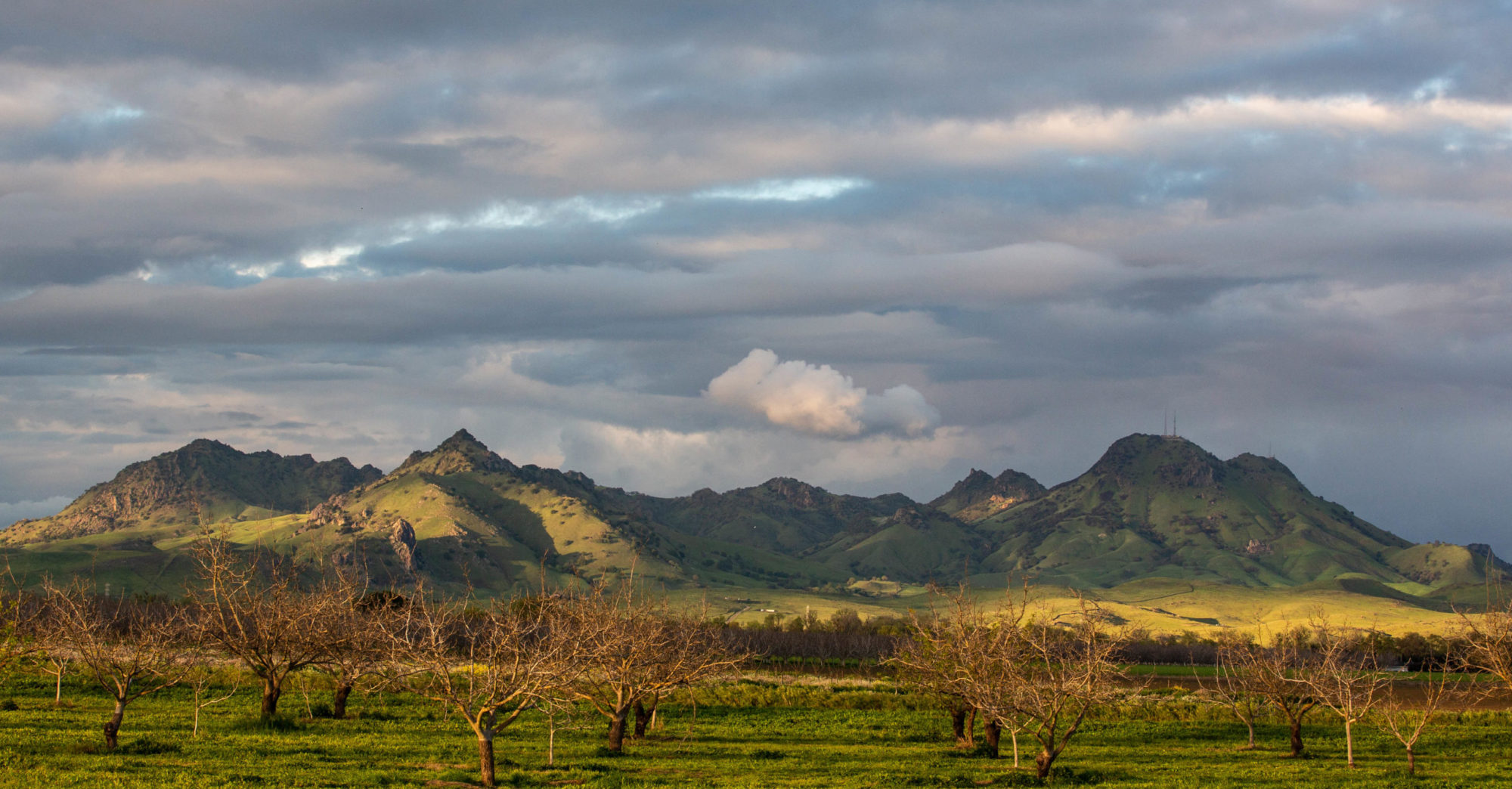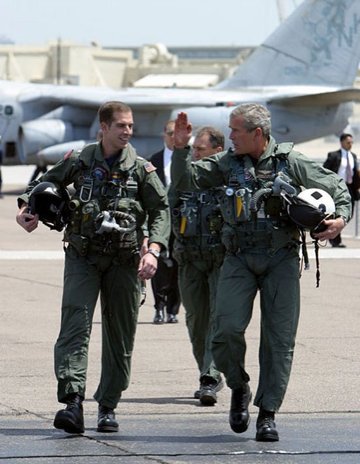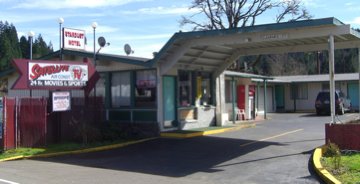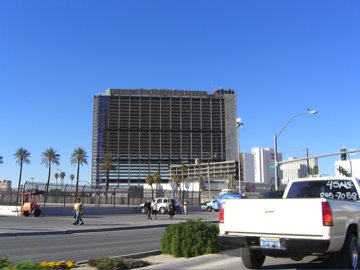
I landed here about 3:30, got a car at about 4, and drove in very slow traffic up The Strip to see what, if anything, was going on at the Stardust. Nothing was visible from the street, anyway, though I’m sure the demolition crews and pyrotechnics and lighting technicians were busy. This is the Stardust–the shell of the 32-story built in 1991 and a satellite nine-story tower at the right–shot from the car across Las Vegas Boulevard at about 5 p.m. I checked into my hotel, the Platinum, on Flamingo, then walked up the Strip to try to get pictures of the Stardust before sunset. I didn’t make it, but the lighting along the street was wonderful and it turned out to be an advantage to show up while it was getting dark. The lighting crew was experimenting with projecting different colors on the tower. Most passers-by didn’t seem to pay much attention, but some were taking pictures. I asked one woman in a strip mall parking lot whether she was going to watch the show after midnight, and she said she and her husband had, by coincidence, gotten a room in the Riviera with a view across the to the Stardust site. Some luck. I expect the streets will be packed by 2 a.m. The tower is supposed to come down, after four minutes of fireworks and other special effects, at 2:35.
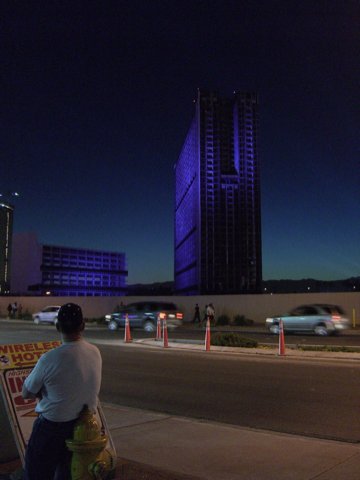
Bay Area Travel Notes
I may have established the minimum leeway one can leave home from Berkeley, take BART to the airport, and still get on one’s reserved flight.
I had a 2 p.m. flight to Las Vegas. I planned to leave home at 11:30, figuring it might take an hour and a half to get to the airport on BART. That timing would have put me at the airport an hour ahead of time. Through one thing and another, I didn’t actually get out of the house until 12:05 p.m. The BART station is about a six- or seven-minute walk, so I was probably there about 12:12. The train to San Francisco arrived at about 12:21. I grabbed a copy of the timetable and saw that the airport train I needed to transfer to wouldn’t arrive at SFO until 1:31. Gee, that would be cutting it close, but there was nothing to do but take the ride and hope there wasn’t a gigantic security backup. The trains were on time, and I actually got off BART at the airport at 1:30. I waited a couple minutes for the shuttle train to the terminal. There was no line at the security checkpoint; the only delay was the usual absurdity: jacket off, shoes off, laptop out of my bag and in a separate tray; in all, I had to to put four separate pieces onto the X-ray conveyor. The TSA guy opened my small suitcase to confiscate my toothpaste, but otherwise I made it through the check quickly. The gate was very close to the checkpoint, and I made it on board at 1:48. Closer than I would have liked, but all’s well that ends well.
Technorati Tags: travel
More Stardust Memories
As part of my relentless pursuit of information on the fabulous Stardust Motel in Redding, I noticed a news development in Las Vegas: the Stardust, once a mobster-run gambling palace whose sordid history served as the model for Martin Scorsese’s “Casino,” is about to be demolished. Or to be more precise: demolition crews have been tearing down the satellite buildings around the 63-acre site since the joint closed last November 1. The remaining job consists of imploding a 32-story hotel tower in the center of the site. Although Boyd Gaming, the company that took over the property from its mob owners in the early 1980s, won’t say when the tower will come down, bloggers–notably Joel Rosales of the excellent Leaving Las Vegas (his page documenting the Stardust demo is here) and freelance reporter Steve Friess–have pinned down the date and time as sometime between 2 a.m. and 5 a.m. on March 13; in other words, after midnight tonight. Long story made short, I’m flying down there this afternoon to do a freelance story on the event.
At this point, large-scale hotel demolitions are as much a part of the Las Vegas scene as the construction cranes that grow out of the rubble. According to one detailed list, at Las Vegas Today and Tomorrow, the Stardust is the city’s 14th major structure brought down since the first headline event, the implosion of the Dunes in 1993.
One of the striking aspects in the little bit of research I’ve done on the Stardust and the process of clearing the Strip of older buildings to put up ever more spectacular new complexes is the nostalgia projected onto the demolition events and the shocking recency of the structures casino owners are getting rid of. Sure, Las Vegas hotels are little more than barracks for the gambling masses; owners don’t want to make the rooms too nice for most visitors because that might cut into the time people spend down at the slots. And yes, the hotel facilities are used hard by the tens of millions of vacationers and convention-goers who show up every year; so everything needs to be made over just to get people in the door. Still, the Stardust tower that’s supposed to fall tonight is all of 16 years old. What’s to feel sad about?
The nostalgia doesn’t attach to that building, naturally. It attaches to the history, which stretches all the way back to the late ’50s: the Paleozoic Era in Vegas terms. People remember the shows (the Stardust’s Lido is reputed to have offered Vegas’s first topless revue), the real-life mobsters and celebrities, Siegfried and Roy, Wayne Newton, the cheap rooms and cheap eats, the jackpots, the decades that many employees stayed to serve the throngs. The Stardust hotel is far from the youngest building flattened and scraped off the desert floor to make way for something new: As part of the process of redeveloping the Desert Inn site for a complex of new resorts, Steve Wynn had a seven-year-old hotel tower dynamited a few years back. The economics of the place–land going at $30 million an acre and owners and investors chasing a crowd of visitors willing to spend more and more for their Vegas excursions–make knocking down a not-so-old building to put up something new and breathtaking an easy choice.
Anyway. The street in front of the Stardust. That’s where I’ll be tonight. Check out a scoop from the Steve Friess site: The detailed program for the sendoff fireworks show (it’s an eight-page PDF document, fyi).
[Image from: TypeMuseum]
On the Bike: Ink Grade
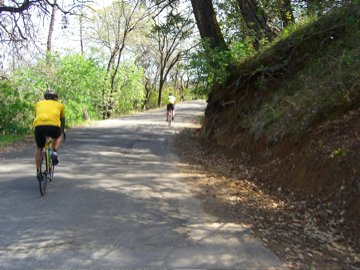
My friends Pete Danko (nearer the camera) and David Darlington (up ahead) during a ride we took Saturday from Yountville (just north of Napa), into the hills east of the Napa Valley up to Pope Valley, then back over the hills to the Napa Valley near Oakville. In the picture, we’re going up Ink Grade on our return–a mostly gentle, narrow, winding, shaded climb with virtually no traffic. We’ve done this ride together before, but yesterday we went out so Dave could take pictures for a Napa Valley cycling article he wrote for Wine and Spirits magazine; Pete and I got to star in lots of pictures (though it’s unclear if any of them will be published, because I think he found some more comely cyclist/models late in the ride). Stopping often to take pictures made us really take it easy for most of the day, which was a great change from my usual “I’ve got to cover X miles today” approach to riding.
Technorati Tags: california, cycling, napa valley
Guest Observation: Mesopotamia
“Now I ain’t no student
Of ancient culture
Before I talk
I should read a book
But there’s one thing that I do know
There’s a lot of ruins in Mesopotamia.”
(White House photo)
Mixed Marriage
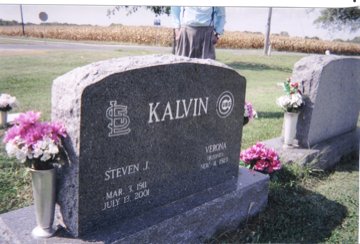
I’ve just started to scan in some pictures from a trip Dad and I took in September 2004. From Chicago, we went down to Cairo, crossed the Mississippi, then took a ferry from Dorena, Missouri, back to Hickman, Kentucky. One of the stops on our itinerary was the cemetery in Mount Olive, Illinois, about 50 miles northeast of St. Louis, where labor saint “Mother” Mary Jones is buried. My older son Eamon and I had happened across the spot on our way back to California a few months earlier. When we saw the informational sign on southbound Interstate 55–“Mother Jones Monument”–I was surprised. What was she doing out here, in the middle of nowhere? But the sign at the gate of a graveyard less than a mile from town and the interstate explained her presence: “Union Miners Cemetery,” it read. And on the arch above the gate, the legend was: “Resting Place of Good Union People.” You don’t know or tend to forget if you’re not from the area that this part of Illinois has a long coal-mining history and one marked by violence against union organizers and members. So: she’s there among the people she fought for. I’ve got some pictures I’ll scan in and post eventually.
While we were there, Dad and I strolled through the cemetery and another one just across the road. It was at the latter that we came across the headstone above. That south-central part of Illinois is divided between Cubs and Cardinals fans. Here’s a case where those bitter differences were put aside for a lifetime partnership (I note that the Cards’ fan lived to age 90; his Cubs’ fan wife would have been 80 when this picture was taken.
When It Was Fun to Fly
Salon’s weekly “Ask the Pilot” column recalls the days when lots of people actually looked forward to getting on an airliner (me–I still like flying, even though the whole experience around it has become creepy and unpleasant):
“… [T]ry to imagine the following: You wake up early for the 45-minute subway ride to Logan International Airport in Boston. The shuttle bus brings you to Terminal C, where you stand in line to be frisked and X-rayed before reaching an overcrowded departure lounge. Half an hour later your flight pushes back, languishes in a taxiway queue for several minutes, then finally takes off. So far this is nothing exceptional, but here’s the twist: The plane’s scheduled destination is, well, Boston. The jet never climbs to more than 10,000 feet. It makes a lazy circuit above the North Shore coastline, swings eastward toward Cape Cod, then circles west in the direction of Logan. Fifteen minutes later, the landing gear clunks into place, and just like that you’re back where you started. You disembark, with smiles and handshakes all around, head for the shuttle bus, and take the subway home again.”
Stardust Memories
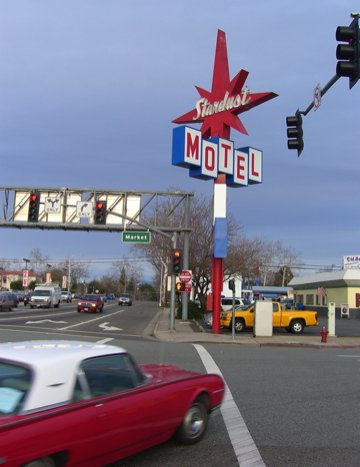
Above, the fabulous Stardust Motel in Redding, California. Well, the sign is fabulous, and that’s about all of the motel you can see in this picture. We passed by Friday afternoon, northbound to Eugene, and stopped across the street for some $3-a-gallon gas. We made the same stop, which also involved a Starbucks on an adjacent corner, on the way back south Sunday night. The motel didn’t look like it was open, and the sign was unlit.
Below, the humbler Stardust Motel of Curtin, Oregon, just off Interstate 5 near Drain. Kate spotted a sign for it on the way north, but it was after dark and we were in a hurry and didn’t stop. Returning home, we looked out for it and pulled off the highway, thinking that we’re starting a collection of Stardust Motel photos. This place was definitely open; the sign in the office window says so.
Technorati Tags: oregon, interstate 5, travel
Query of the Day
The Infospigot traffic logs show an unusual number of people arriving here after Googling the question, “Which popular singer is the great-great grandson of Daylight Saving Time inventor William Willett?”
The answer, if you believe the Wikipedia entries on Willett and Daylight Savings Time is Chris Martin of Coldplay.
What I’m not clear on is where the question was asked that so many people are looking for the answer. Six o’clock Mass? [Later: I see that nearly all the Willett/Martin queries are coming from Canada, and more specifically, apparently from the Toronto area starting during the morning commute hour. So I’m guessing this is an early-morning trivia question posed on a radio show up there.]
Technorati Tags: trivia
As Seen on TV
First: Tyra Banks. Kate had put on her show because she said some of the teachers she works with are always talking about have mentioned her. Kate didn’t know from Tyra Banks. All I thought I knew was that she was a model (sorry–supermodel) who might have done some acting. I didn’t know she had a show, but there it was, an Oprah/Montel-esque self-help fest on the subject of anorexia and bulimia. We tuned in long enough, about 45 seconds, to hear Ms. Banks cry out to her audience, “You don’t have to be consumed by an eating disorder!” There–that’s Tyra Banks.
Next.
KTVU’s 10’Clock News. One of the stories teased on the show open was about the “Nobel Peace Prize” that had gone missing at the University of California at Berkeley. The story: Police had located the medallion and a suspect. I puzzled over what Nobel Peace Prize might be on the Cal campus; though the university is given to tiresome boasting about the number of Nobel laureates among its faculty, I don’t recall ever hearing of anyone who got the peace prize.
But before I could think more about that, the anchors launched into tonight’s top story: A burglary rampage in a rich little town, Orinda, on the other side of the hills. Then the details emerged: Over the last two weeks, police say, five burglaries have been reported in the town. The M.O.? Scary: Someone’s entering residences during the day through unlocked doors. The loot? Oh, big-ticket stuff: iPods, laptop computers, “even jewelry.” In other words, the kind of garden-variety rip-offs that urban dwellers are all too familiar with. It wasn’t even clear from the cop who appeared on camera that the police think it’s an unusual occurrence. The KTVU reporter did locate a woman who had a harrowing story about a confrontation with a burglar last summer; the intruder beat her and threatened her before getting away with $13,000 in jewelry. But as the on-camera cop said, that incident apparently has nothing to do with the current spate of thefts.
You could make a case for having the story somewhere on the show: “Genteel folk fret over predators in sylvan paradise.” But why was it the lead story? Probably because someone at KTVU lives in Orinda and either had their home broken into or knows a neighbor or two who have.
On to the Nobel Peace Prize story: Well, it turns out that someone tipped off UC police that a student had stolen the solid gold medal from Lawrence Hall of Science the other day. The cops went out and picked up the kid, who said he took the medallion from a display case “on a whim.” But it was the physics prize awarded to Ernest O. Lawrence in 1939, not the peace prize. If you care, and news people are paid to and should be doing something else if they don’t, there’s a big difference between the two medals.
Eventually, way down in the show, KTVU got around to the less important stories like Iraq and the Scooter Libby fallout and what have you. Overall, 60 minutes that barely moves the needle from “bad” to “mediocre.”
